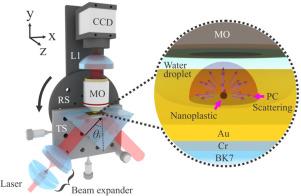基于等离子体耦合散射显微镜的单纳米塑料检测
IF 4.9
3区 工程技术
Q2 ENGINEERING, ELECTRICAL & ELECTRONIC
引用次数: 0
摘要
由于纳米塑料对生态系统和人类健康的潜在影响,其在水生环境中日益增加的存在引起了重大关注。传统的检测技术在分辨率、灵敏度和成本效益方面存在局限性,因此开发新的方法至关重要。在这项研究中,我们介绍了等离子体耦合散射显微镜(PCSM)作为一种高灵敏度检测和表征单个纳米塑料颗粒的新方法。与传统的表面等离子体共振技术(分析体折射率变化)不同,PCSM通过利用等离子体耦合散射实现对单个纳米粒子的局部检测。实验验证了该方法的有效性,将不同直径的聚苯乙烯纳米颗粒浸入水中,并在克雷茨曼结构的变体中覆盖一层金薄膜。采用t矩阵法进行理论建模,与实验结果吻合较好。本研究证明了在可控条件下利用PCSM进行单粒子检测的技术可行性。虽然它尚未应用于环境基质,但该方法涵盖了广泛的粒径范围(1-2500 nm),适用于检测常见的塑料污染物。该方法还显示出扩展到其他纳米级水污染物的潜力,支持其作为环境监测和污染评估的多功能工具的未来发展。本文章由计算机程序翻译,如有差异,请以英文原文为准。

Single-nanoplastic detection based on plasmon-coupled scattering microscopy
The increasing presence of nanoplastics in aquatic environments has raised significant concerns due to their potential impact on ecosystems and human health. Traditional detection techniques face limitations in resolution, sensitivity, and cost-effectiveness, making the development of new methodologies essential. In this study, we introduce Plasmon-Coupled Scattering Microscopy (PCSM) as a novel approach for high-sensitivity detection and characterization of single nanoplastic particles. Unlike conventional Surface Plasmon Resonance techniques, which analyze bulk refractive index variations, PCSM enables localized detection of individual nanoparticles by leveraging plasmon-coupled scattering. This method was experimentally validated using polystyrene nanoparticles of different diameters, immersed in water over a gold thin film within a variant of the Kretschmann configuration. Theoretical modeling was performed using the T-matrix method, showing strong agreement with experimental results. This study demonstrates the technical feasibility of single-particle detection using PCSM under controlled conditions. Although it has not yet been applied to environmental matrices, the approach covers a broad particle size range (1–2500 nm) and is suitable for detecting commonly reported plastic pollutants. The method also shows potential for extension to other nanoscale water contaminants, supporting its future development as a versatile tool for environmental monitoring and pollution assessment.
求助全文
通过发布文献求助,成功后即可免费获取论文全文。
去求助
来源期刊

Sensors and Actuators A-physical
工程技术-工程:电子与电气
CiteScore
8.10
自引率
6.50%
发文量
630
审稿时长
49 days
期刊介绍:
Sensors and Actuators A: Physical brings together multidisciplinary interests in one journal entirely devoted to disseminating information on all aspects of research and development of solid-state devices for transducing physical signals. Sensors and Actuators A: Physical regularly publishes original papers, letters to the Editors and from time to time invited review articles within the following device areas:
• Fundamentals and Physics, such as: classification of effects, physical effects, measurement theory, modelling of sensors, measurement standards, measurement errors, units and constants, time and frequency measurement. Modeling papers should bring new modeling techniques to the field and be supported by experimental results.
• Materials and their Processing, such as: piezoelectric materials, polymers, metal oxides, III-V and II-VI semiconductors, thick and thin films, optical glass fibres, amorphous, polycrystalline and monocrystalline silicon.
• Optoelectronic sensors, such as: photovoltaic diodes, photoconductors, photodiodes, phototransistors, positron-sensitive photodetectors, optoisolators, photodiode arrays, charge-coupled devices, light-emitting diodes, injection lasers and liquid-crystal displays.
• Mechanical sensors, such as: metallic, thin-film and semiconductor strain gauges, diffused silicon pressure sensors, silicon accelerometers, solid-state displacement transducers, piezo junction devices, piezoelectric field-effect transducers (PiFETs), tunnel-diode strain sensors, surface acoustic wave devices, silicon micromechanical switches, solid-state flow meters and electronic flow controllers.
Etc...
 求助内容:
求助内容: 应助结果提醒方式:
应助结果提醒方式:


